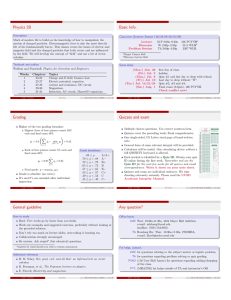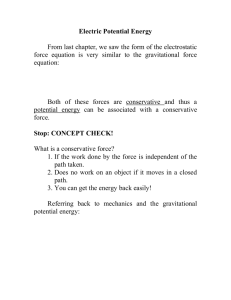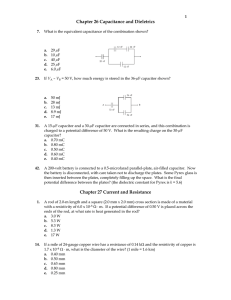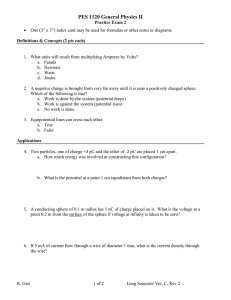Energy of electric force Electrostatic potential
advertisement
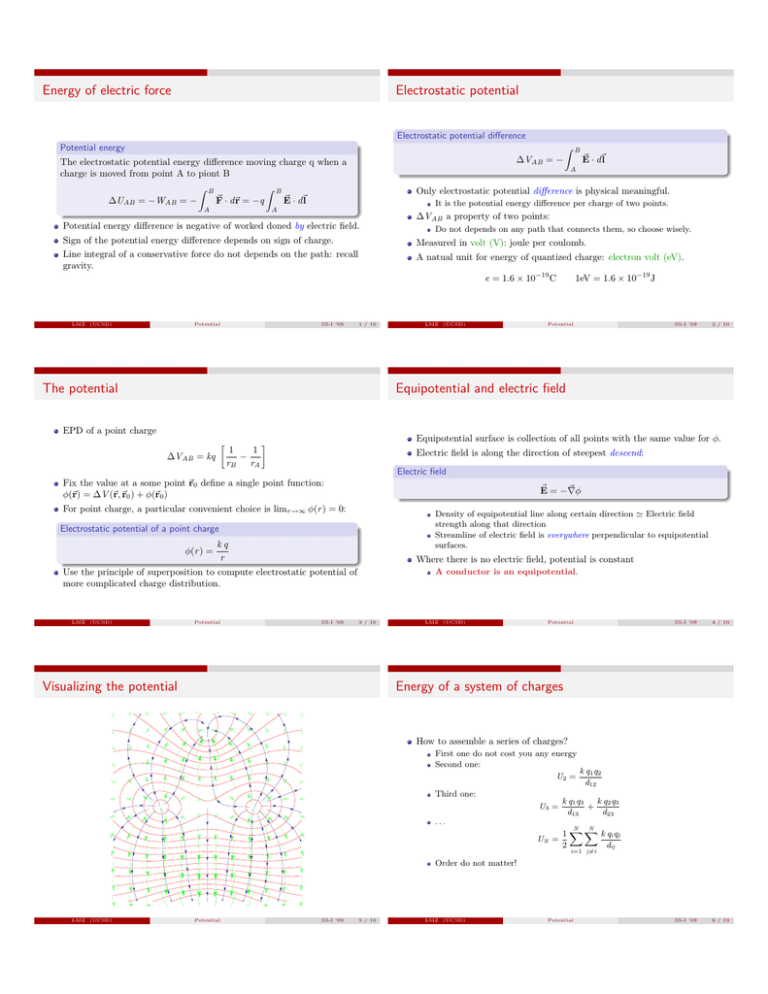
Energy of electric force Electrostatic potential Electrostatic potential difference Potential energy B Z Z B ∆UAB = −WAB = − ~ · d~r = −q F Z A Only electrostatic potential difference is physical meaningful. B ~ · d~l E It is the potential energy difference per charge of two points. A A ~ · d~l E ∆VAB = − The electrostatic potential energy difference moving charge q when a charge is moved from point A to piont B ∆VAB a property of two points: Potential energy difference is negative of worked doned by electric field. Sign of the potential energy difference depends on sign of charge. Line integral of a conservative force do not depends on the path: recall gravity. Do not depends on any path that connects them, so choose wisely. Measured in volt (V): joule per coulomb. A natual unit for energy of quantized charge: electron volt (eV). e = 1.6 × 10−19 C LMZ (UCSD) Potential SS-I ’09 1 / 10 The potential LMZ (UCSD) 1eV = 1.6 × 10−19 J Potential SS-I ’09 2 / 10 Equipotential and electric field EPD of a point charge Equipotential surface is collection of all points with the same value for φ. ∆VAB = kq 1 1 − rB rA Electric field is along the direction of steepest descend: Electric field Fix the value at a some point ~r0 define a single point function: φ(~r) = ∆V (~r,~r0 ) + φ(~r0 ) ~ = −∇φ ~ E For point charge, a particular convenient choice is limr→∞ φ(r) = 0: Density of equipotential line along certain direction ' Electric field strength along that direction Streamline of electric field is everywhere perpendicular to equipotential surfaces. Electrostatic potential of a point charge φ(r) = kq r Where there is no electric field, potential is constant Use the principle of superposition to compute electrostatic potential of more complicated charge distribution. LMZ (UCSD) Potential SS-I ’09 A conductor is an equipotential. 3 / 10 Visualizing the potential LMZ (UCSD) Potential SS-I ’09 4 / 10 SS-I ’09 6 / 10 Energy of a system of charges How to assemble a series of charges? First one do not cost you any energy Second one: k q 1 q2 U2 = d12 Third one: k q 1 q3 k q 2 q3 + U3 = d13 d23 ... N N 1 X X k q i qj UN = 2 dij i=1 j6=i Order do not matter! LMZ (UCSD) Potential SS-I ’09 5 / 10 LMZ (UCSD) Potential More on conductor Capacitor Charge on conductor automatically redistribute to keep zero electric field inside each conductor each conductor an equipotential surface. connected conductors have the same potential; isolated conductors do not have to have the same potential. In general any systems of charged conductor form a capacitor. The most usual type involve two “parallel” plates. Store energy in form of electric field by developing a potential difference across the two plate proportional to the charge of each plate: Capacitance Transfer charge Q from one parallel plate conductor to another: one plate will end up with charge +Q and the other −Q cost energy: d W = Q2 20 A C = Q/V Q measured in coulomb, V in volt, C in farad. Where did the energy go? In the electric field! A capacitor stores charge and energy: Energy density of electric field Energy stored in capacitor 1 uE = 0 E 2 . 2 LMZ (UCSD) Potential U = SS-I ’09 7 / 10 The capacitance LMZ (UCSD) QV CV 2 Q2 = = 2 2 2C Potential SS-I ’09 8 / 10 Circuits of capacitors Parallel plates (-like) capacitor: Parallel connection: Capacitance of parallel plates capacitor C = 0 A d A capacitor can have some dielectric material between the plates instead of empty space 0 → . Usually > 0 . (screenign) Dielectric responds to external electric field by charge-polarization and creates a opposing field. reduced total field reduces energy needed to put charge on capacitor plates. capacitance increases both ends connected/shorted same voltage across each capacitor: V1 = V2 = V3 = · · · charges additive: Qtotal = Q1 + Q2 + Q3 + · · · capacitance add: Ctotal = C1 + C2 + C3 + · · · Series connection: one end connected/shorted same charge: Q1 = Q2 = Q3 = · · · voltage additive: Vtotal = V1 + V2 + V3 + · · · inverse of capacitance add: 1 1 1 1 = + + + ··· Ctotal C1 C2 C3 What happen when C changes depends on how the capacitor is connected: Energy U = Charge do not change for an isolated capacitor(s). Voltage do not change for a capacitor connected to a battery LMZ (UCSD) Potential SS-I ’09 9 / 10 LMZ (UCSD) QV 2 always additive. Check for yourself! Potential SS-I ’09 10 / 10


